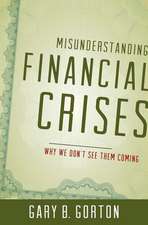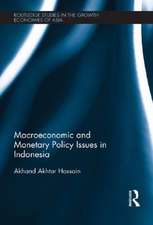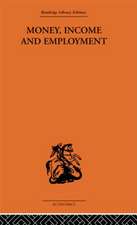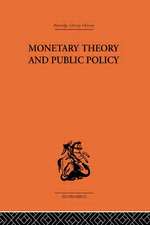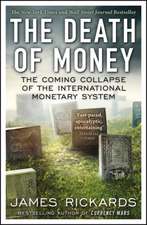The Postwar International Money Crisis: An Analysis: Economic History
Autor Victor Argyen Limba Engleză Paperback – 19 oct 2010
| Toate formatele și edițiile | Preț | Express |
|---|---|---|
| Paperback (1) | 198.47 lei 6-8 săpt. | |
| Taylor & Francis – 19 oct 2010 | 198.47 lei 6-8 săpt. | |
| Hardback (1) | 718.39 lei 6-8 săpt. | |
| Taylor & Francis – 3 noi 2005 | 718.39 lei 6-8 săpt. |
Din seria Economic History
- 34%
 Preț: 1050.05 lei
Preț: 1050.05 lei - 34%
 Preț: 1043.40 lei
Preț: 1043.40 lei - 34%
 Preț: 1045.74 lei
Preț: 1045.74 lei - 33%
 Preț: 1058.15 lei
Preț: 1058.15 lei - 34%
 Preț: 1045.01 lei
Preț: 1045.01 lei - 34%
 Preț: 1050.42 lei
Preț: 1050.42 lei - 34%
 Preț: 1049.52 lei
Preț: 1049.52 lei - 34%
 Preț: 1186.90 lei
Preț: 1186.90 lei - 21%
 Preț: 359.11 lei
Preț: 359.11 lei - 34%
 Preț: 1045.01 lei
Preț: 1045.01 lei - 34%
 Preț: 1046.82 lei
Preț: 1046.82 lei - 34%
 Preț: 1050.42 lei
Preț: 1050.42 lei - 34%
 Preț: 1046.09 lei
Preț: 1046.09 lei - 34%
 Preț: 1044.12 lei
Preț: 1044.12 lei - 34%
 Preț: 1050.05 lei
Preț: 1050.05 lei - 21%
 Preț: 357.87 lei
Preț: 357.87 lei - 34%
 Preț: 1046.09 lei
Preț: 1046.09 lei - 34%
 Preț: 1044.68 lei
Preț: 1044.68 lei - 34%
 Preț: 766.66 lei
Preț: 766.66 lei - 34%
 Preț: 1044.68 lei
Preț: 1044.68 lei - 34%
 Preț: 1047.35 lei
Preț: 1047.35 lei - 34%
 Preț: 1044.68 lei
Preț: 1044.68 lei - 54%
 Preț: 709.75 lei
Preț: 709.75 lei - 34%
 Preț: 711.55 lei
Preț: 711.55 lei - 34%
 Preț: 1052.22 lei
Preț: 1052.22 lei - 34%
 Preț: 1045.01 lei
Preț: 1045.01 lei - 34%
 Preț: 1044.48 lei
Preț: 1044.48 lei - 34%
 Preț: 1047.90 lei
Preț: 1047.90 lei - 34%
 Preț: 1047.90 lei
Preț: 1047.90 lei - 22%
 Preț: 355.15 lei
Preț: 355.15 lei - 54%
 Preț: 708.69 lei
Preț: 708.69 lei - 34%
 Preț: 1045.74 lei
Preț: 1045.74 lei - 34%
 Preț: 1044.12 lei
Preț: 1044.12 lei - 34%
 Preț: 1047.19 lei
Preț: 1047.19 lei - 33%
 Preț: 1055.64 lei
Preț: 1055.64 lei - 34%
 Preț: 1049.88 lei
Preț: 1049.88 lei - 34%
 Preț: 1045.57 lei
Preț: 1045.57 lei - 34%
 Preț: 1051.86 lei
Preț: 1051.86 lei - 54%
 Preț: 709.75 lei
Preț: 709.75 lei - 54%
 Preț: 714.80 lei
Preț: 714.80 lei - 34%
 Preț: 1045.01 lei
Preț: 1045.01 lei - 34%
 Preț: 712.09 lei
Preț: 712.09 lei - 34%
 Preț: 1049.88 lei
Preț: 1049.88 lei - 34%
 Preț: 1046.82 lei
Preț: 1046.82 lei - 34%
 Preț: 1044.84 lei
Preț: 1044.84 lei - 34%
 Preț: 1043.05 lei
Preț: 1043.05 lei - 34%
 Preț: 1043.76 lei
Preț: 1043.76 lei - 34%
 Preț: 1049.52 lei
Preț: 1049.52 lei - 34%
 Preț: 1049.88 lei
Preț: 1049.88 lei - 34%
 Preț: 1043.95 lei
Preț: 1043.95 lei
Preț: 198.47 lei
Preț vechi: 338.10 lei
-41% Nou
Puncte Express: 298
Preț estimativ în valută:
37.98€ • 39.18$ • 32.15£
37.98€ • 39.18$ • 32.15£
Carte tipărită la comandă
Livrare economică 04-18 martie
Preluare comenzi: 021 569.72.76
Specificații
ISBN-13: 9780415607568
ISBN-10: 0415607566
Pagini: 456
Dimensiuni: 156 x 234 mm
Greutate: 0.84 kg
Ediția:1
Editura: Taylor & Francis
Colecția Routledge
Seria Economic History
Locul publicării:Oxford, United Kingdom
ISBN-10: 0415607566
Pagini: 456
Dimensiuni: 156 x 234 mm
Greutate: 0.84 kg
Ediția:1
Editura: Taylor & Francis
Colecția Routledge
Seria Economic History
Locul publicării:Oxford, United Kingdom
Cuprins
Preface A Summary Perspective on the Issues Part 1: International Monetary Regimes and the Euro-Dollar System 1. The Gold Standard Regime 2. The IMF System 3. The Postwar Experience – 1946 to 1967 4. Reform Proposals – Mark I: The Early 1960s 5. Special Drawing Rights (SDRs) 6. Continuing Crises and the Breakdown of Bretton Woods 7. The Growth of the Euro-Currency System 8. The Oil Price Shock of 1974 – Financial Impacts 9. Deficiencies of the IMF System and Reasons for Its Collapse 10. Reforms and Reform Discussions – Mark II: 1968 to 1978 Part 2: The Analytical Framework for an Open Economy 11. A Neo-Keynesian Model of Aggregate Demand and Aggregate Supply 12. Monetarist Models – I: The Expectations-Augmented Phillips Curve and the Natural Rate of Unemployment 13. Monetarist Models – II: A Two-Sector Model 14. The Choice of Model – Issues and Evidence Part 3: Global Inflation and Unemployment 15. Theories of Global Inflation – The 1970s 16. Public Sector Growth and Inflation – 1965 to 1975 17. Global Inflation – The Evidence 18. The Downturn (1974–1975) and the Conservative Reaction (1976–1978) Part 4: Managed Floats – 1973 to 1978 19. The Forward Market – Analysis and Evidence 20. Exchange Rate Behaviour – Theoretical Analysis 21 Exchange Rate Behaviour – The Evidence Part 5: Choice of Exchange Rate Regime 22. The Effectiveness of Macro-Policy 23. Insulation of the Domestic Economy from Random Disturbances 24. Exchange Rate Regime – World Inflation and Unemployment 25. Exchange Rate Flexibility, Trade, Reserve Demand and Vicious Circles 26. Costs and Benefits of a Managed Float 27. Monetary Unions – Analysis and Application to the EEC Part Six: Macro-Policy 28. Conventional Macro-Policy – Targets, Instruments and Assignments 29. The New Economic Environment and Its Policy Implications 30. Policies for Stagflation – I: A Review of Some Proposals 31. Policies for Stagflation – II: Prices and Incomes Policies (PIP) 32. A Framework for Macro-Policy Bibliography Index


